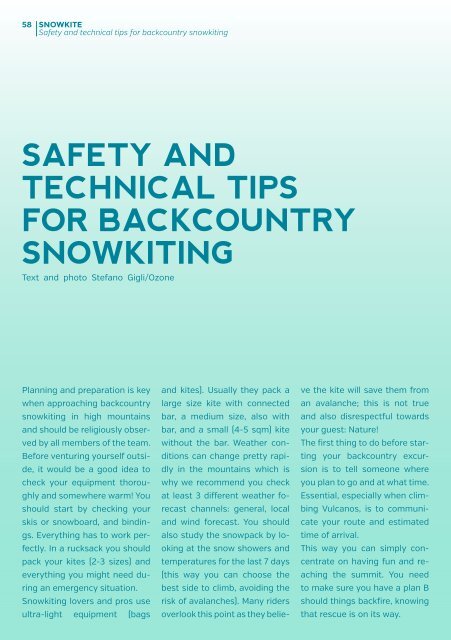Create successful ePaper yourself
Turn your PDF publications into a flip-book with our unique Google optimized e-Paper software.
58SNOWKITESafety and technical tips for backcountry snowkitingSAFETY ANDTECHNICAL TIPSFOR BACKCOUNTRYSNOWKITINGText and photo Stefano Gigli/OzonePlanning and preparation is keywhen approaching backcountrysnowkiting in high mountainsand should be religiously observedby all members of the team.Before venturing yourself outside,it would be a good idea tocheck your equipment thoroughlyand somewhere warm! Youshould start by checking yourskis or snowboard, and bindings.Everything has to work perfectly.In a rucksack you shouldpack your kites (2-3 sizes) andeverything you might need duringan emergency situation.Snowkiting lovers and pros useultra-light equipment (bagsand kites). Usually they pack alarge size kite with connectedbar, a medium size, also withbar, and a small (4-5 sqm) kitewithout the bar. Weather conditionscan change pretty rapidlyin the mountains which iswhy we recommend you checkat least 3 different weather forecastchannels: general, localand wind forecast. You shouldalso study the snowpack by lookingat the snow showers andtemperatures for the last 7 days(this way you can choose thebest side to climb, avoiding therisk of avalanches). Many ridersoverlook this point as they believethe kite will save them froman avalanche; this is not trueand also disrespectful towardsyour guest: Nature!The first thing to do before startingyour backcountry excursionis to tell someone whereyou plan to go and at what time.Essential, especially when climbingVulcanos, is to communicateyour route and estimatedtime of arrival.This way you can simply concentrateon having fun and reachingthe summit. You needto make sure you have a plan Bshould things backfire, knowingthat rescue is on its way.


















